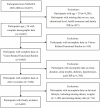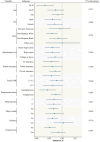L-shaped association between oxidative balance score and vision-related functional burden in adults in the United States, NHANES 2005-2008
- PMID: 40386211
- PMCID: PMC12082837
- DOI: 10.3389/fnut.2025.1507889
L-shaped association between oxidative balance score and vision-related functional burden in adults in the United States, NHANES 2005-2008
Abstract
Objective: This study aims to investigate the relationship between oxidative balance score (OBS) and vision-related functional burden (VRFB) in US adults.
Methods: The study utilized data from two consecutive cycles of the National Health and Nutrition Examination Survey (NHANES) from 2005 to 2008. A multivariate weighted logistic regression model was employed to explore the relationship between OBS and VRFB in the general population and subgroups, while the interaction effects were tested with a likelihood test. Restricted cubic spline was utilized to assess the nonlinear association of OBS with VRFB. Sensitivity analyses were performed to test the robustness of the results.
Results: A total of 6,682 participants aged 20 years and older were included in the NHANES database. A negative association between OBS and VRFB was observed in the fully adjusted model, with an odds ratio (OR) of 0.968 [95% confidence interval (CI): 0.949-0.987]. Compared with the lowest quartile of OBS, the second (OR: 0.669, 95%CI: 0.486-0.922), the third (OR: 0.589, 95%CI: 0.403-0.859), and highest (OR: 0.554, 95%CI: 0.359-0.855) quartiles of OBS were associated with a reduced risk of VRFB. An L-shaped association was displayed between OBS and VRFB (P for nonlinear = 0.016). Notably, when the analysis was stratified by employment status, a significant interaction between OBS and VRFB was observed (P for interaction < 0.05). The protective effect of OBS was more pronounced among the unemployed. The results were found to be robust in sensitivity analyses.
Conclusion: This study found an L-shaped relationship between OBS and VRFB among U.S. adults aged 20 years and older. This novel finding suggests that maintaining a favorable oxidative balance through modifiable dietary and lifestyle (such as increased physical activity, smoking cessation, reduced alcohol consumption) may help protect functional vision. We also observed a stronger negative association between OBS and VRFB among the unemployed. This study provides new insights into the prevention of functional vision loss, highlighting the importance of not only dietary and lifestyle factors but also considering different subgroups, such as the unemployed. Further longitudinal studies are required to further validate these observations and elucidate the underlying mechanisms, particularly in elucidating causal relationships among variables, controlling for confounding factors, and examining the development of visual function.
Keywords: L-shaped curve; NHANES; adults; oxidative balance score; vision-related functional burden.
Copyright © 2025 Li, Ye, Li, Liu, Yang, Lu, Jin and Liu.
Conflict of interest statement
The authors declare that the research was conducted in the absence of any commercial or financial relationships that could be construed as a potential conflict of interest.
Figures



Similar articles
-
Association between chronic kidney disease and oxidative balance score: National Health and Nutrition Examination Survey (NHANES) 2005-2018.Front Nutr. 2025 Jan 3;11:1406780. doi: 10.3389/fnut.2024.1406780. eCollection 2024. Front Nutr. 2025. PMID: 39830066 Free PMC article.
-
Associations of oxidative balance score with total abdominal fat mass and visceral adipose tissue mass percentages among young and middle-aged adults: findings from NHANES 2011-2018.Front Nutr. 2023 Dec 5;10:1306428. doi: 10.3389/fnut.2023.1306428. eCollection 2023. Front Nutr. 2023. PMID: 38115885 Free PMC article.
-
Dietary and lifestyle oxidative balance score was negatively associated with the risk of diabetic kidney disease: NHANES 2005-2020.Acta Diabetol. 2025 Jun;62(6):819-829. doi: 10.1007/s00592-024-02399-7. Epub 2024 Dec 28. Acta Diabetol. 2025. PMID: 39731593 Free PMC article.
-
Association between oxidative balance score and female infertility from the national health and nutrition examination survey 2013-2018.Front Endocrinol (Lausanne). 2024 Jul 30;15:1386021. doi: 10.3389/fendo.2024.1386021. eCollection 2024. Front Endocrinol (Lausanne). 2024. PMID: 39140031 Free PMC article.
-
Association between oxidative balance score and serum uric acid and hyperuricemia: a population-based study from the NHANES (2011-2018).Front Endocrinol (Lausanne). 2024 Jun 20;15:1414075. doi: 10.3389/fendo.2024.1414075. eCollection 2024. Front Endocrinol (Lausanne). 2024. PMID: 38966221 Free PMC article.
References
-
- Bourne RRA, Flaxman SR, Braithwaite T, Cicinelli MV, Das A, Jonas JB, et al. . Magnitude, temporal trends, and projections of the global prevalence of blindness and distance and near vision impairment: a systematic review and meta-analysis. Lancet Glob Health. (2017) 5:e888–e97. 10.1016/S2214-109X(17)30293-0 - DOI - PubMed
LinkOut - more resources
Full Text Sources

